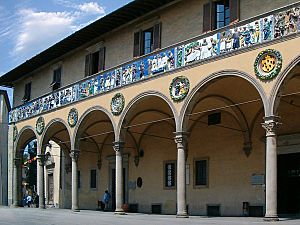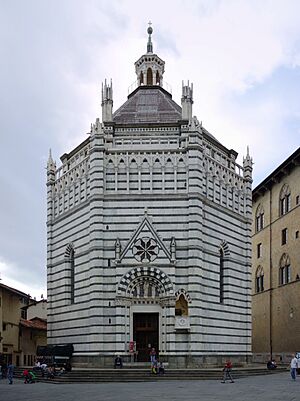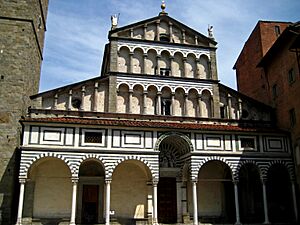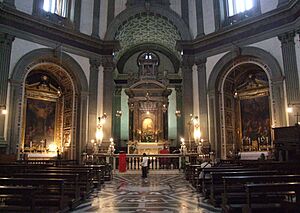Pistoia facts for kids
Quick facts for kids
Pistoia
|
|||
|---|---|---|---|
| Città di Pistoia | |||
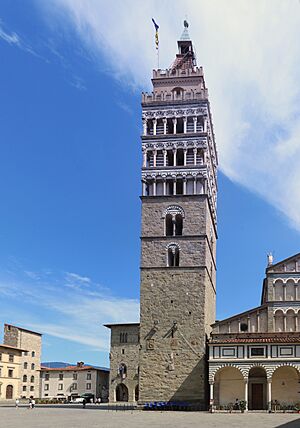
The bell tower of the cathedral in Piazza Duomo
|
|||
|
|||
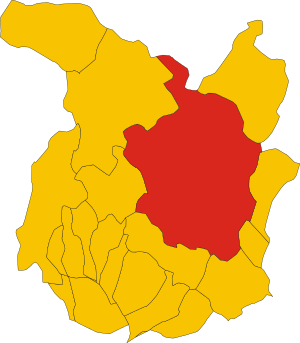
Pistoia within the Province of Pistoia
|
|||
| Country | Italy | ||
| Region | Tuscany | ||
| Province | Pistoia (PT) | ||
| Frazioni | see list | ||
| Area | |||
| • Total | 236.17 km2 (91.19 sq mi) | ||
| Elevation | 65 m (213 ft) | ||
| Population
(31 August 2016)
|
|||
| • Total | 90,363 | ||
| • Density | 382.618/km2 (990.977/sq mi) | ||
| Demonym(s) | Pistoiese (singular), Pistoiesi (plural) | ||
| Time zone | UTC+1 (CET) | ||
| • Summer (DST) | UTC+2 (CEST) | ||
| Postal code |
51100
|
||
| Dialing code | 0573 | ||
| Patron saint | St. Jacopo | ||
| Saint day | July 25 | ||
Pistoia is a city in the Tuscany region of Italy. It is the capital of a province with the same name. The city is located about 30 kilometers (19 miles) west and north of Florence. The Ombrone Pistoiese river, which flows into the Arno River, crosses Pistoia.
Pistoia is a classic Italian medieval city. It attracts many visitors, especially during the summer months. The city is also very well known in Europe for its many plant nurseries.
Contents
History of Pistoia
How Pistoia Began
Pistoia was first known as Pistoria in Latin. It was a place where different ancient groups lived, like the Gauls, Ligures, and Etruscans. Around 600 BC, it became a Roman colony. This happened along the important Via Cassia road. In 62 BC, a famous Roman, Catiline, and his group were defeated nearby.
From the 400s AD, Pistoia became a city with a bishop. During the time of the Lombards (a Germanic people), it was a royal city. It had special rights and importance.
Pistoia as a Free City
Pistoia's best period started in 1177. At this time, it declared itself a free commune. This meant it was a self-governing city. In the years that followed, Pistoia became an important political center. New walls were built, along with many public and religious buildings.
In 1254, the city was taken over by Florence. This led to fighting between two groups called the "Black" and "White" Guelphs. These groups were different noble families. The famous poet Dante Alighieri even mentioned a person from Pistoia in his book Inferno. Pistoia mostly stayed under Florentine control.
Later History and Famous Families
One of the most famous families from Pistoia was the Rospigliosi. They owned farms and traded wool. A member of this family, Giulio Rospigliosi, became Pope Clement IX in 1667. The family also gave several cardinals to the church.
In 1786, an important church meeting called the episcopal synod took place in Pistoia.
Some people believe that the word "pistol" comes from Pistoia. This is because pistols started to be made in the city during the 1500s. Today, Pistoia is also known for its many plant nurseries. These nurseries grow plants that are sold all over. Because of this, Pistoia is famous for its flower markets.
Geography of Pistoia
Pistoia is surrounded by several other towns. These include Agliana, Alto Reno Terme, Cantagallo, Lizzano in Belvedere, Marliana, Montale, Quarrata, Sambuca Pistoiese, San Marcello Piteglio and Serravalle Pistoiese.
Culture and Arts in Pistoia
Pistoia in Books and Movies
- Literature: In a novel by Anatole France, the Ospedale del Ceppo in Pistoia is mentioned. It is praised for the "vigor and truth" shown in its beautiful terracotta art.
- Cinema: Pistoia has been a setting for many movies. Some of these include I Love You in All the Languages in the World, Amici miei, and Medici: Masters of Florence.
Music and Traditions
- Pistoia Blues: This is an international music festival that started in 1980. It is one of the most important blues festivals in Europe. Famous artists like B.B. King, Bob Dylan, and David Bowie have performed here.
- Giostra dell'Orso: This means "Joust of the Bear." It is a traditional ceremony that dates back to the 1300s. Riders would fight against a bear. The ceremony changed over time but stopped in 1666. It was restarted in 1947 and happens every year on July 25.
Main Sights in Pistoia
Pistoia is a medieval city with old walls. Even though it is less visited than some other Tuscan cities, it is charming and well-preserved.
Exploring Piazza del Duomo
The large Piazza del Duomo is the main square. The cathedral stands tall in the square. Other medieval buildings, like the Palazzo del Comune and the Palazzo del Podestà, are also here. In July, the Giostra dell'Orso ("Bear Joust") takes place in this square. Horsemen from different parts of the city compete with lances.
The Cathedral of San Zeno
The first Cathedral of San Zeno was built in the 400s. It burned down in 1108. It was rebuilt in the 1100s and improved until the 1600s. The front of the church has a strong Romanesque style. Inside, there were many Baroque additions, but these were removed in the 1960s.
A special part of the cathedral is the Altar of St James. This is a beautiful example of silversmith work. It was started in 1287 and finished in the 1400s. It has 628 figures and weighs almost a ton. The Romanesque bell tower is about 67 meters (220 feet) tall. It was built on top of an old Lombard tower.
The Baptistry
Also in the square is the 14th-century Baptistry. It is built in the Gothic style. It has white and green striped marble, which is typical of Tuscan Gothic buildings.
The Bishops' Palace
The Palazzo dei Vescovi ("Bishops' Palace") has a Gothic loggia (an open gallery) on its first floor. It was first known in 1091 as a strong noble home. In the 1100s, it became more decorated with mullioned windows and frescoes. Traces of these can still be seen. It was changed again in the mid-1100s and 1200s. The white marble staircase from the 1200s is one of the oldest in Italy for a non-religious building. In the 1300s, the Chapel of St. Nicholas was decorated with stories of saints.
Catilina's Tower
The Tower of Catilina is from the Middle Ages. It stands 30 meters (98 feet) high.
Important Religious Buildings
- Basilica of Our Lady of Humility (Madonna dell'Umiltà) (1509): This church was finished by Giorgio Vasari. It has a large dome that is 59 meters (194 feet) high. The church was started in 1495. The dome was ordered by Cosimo I de' Medici.
- Santissima Annunziata: This is a former Baroque church. It is known for its Chiostro dei Morti ("Cloister of the Dead").
- San Bartolomeo in Pantano (12th century): An old church with interesting history.
- San Giovanni Battista (15th century): This church was damaged during World War II. Now, it is used as a place for exhibitions.
- San Giovanni Battista al Tempio (11th century): This church was once owned by the Knights Templar. Later, it belonged to the Hospitaller Knights.
- San Benedetto (14th century, restored in 1630): This church has an Annunciation painting from 1390. It also has a painting of St Benedict with the Redeemer.
- San Domenico: A historic church with a long past.
- San Francesco (begun 1289): This Franciscan church has an unfinished front with two-colored marble. It has frescoes showing Histories of St. Francis.
- San Giovanni Fuoricivitas (12th–14th century): A Romanesque church.
- San Leone (14th century): This church was made larger in the 1500s-1700s. Its Baroque-Roccoco inside has paintings by famous artists.
- Santa Maria delle Grazie, Pistoia
- Santa Maria in Ripalta (11th century): This church has a large fresco in its apse. It shows the Ascent of Christ.
- San Paolo: Another important church in Pistoia.
- San Pier Maggiore: A significant historical church.
- Pieve di Sant'Andrea: This church holds a famous Pulpit of St. Andrew by Giovanni Pisano.
- Pieve of San Michele in Groppoli: An ancient chapel that is now a parish church.
- La Vergine: A church with historical importance.
Other Interesting Places
- The 14th-century walls: Pistoia used to have four main gates in its old walls. These were taken down in the early 1900s.
- Ospedale del Ceppo (13th century): A historic hospital building.
- Palazzo Panciatichi: A notable palace.
- Medici Fortress of Santa Barbara: This fortress was first built in 1331. It was destroyed by Pistoia's citizens in 1343. It was rebuilt by order of Cosimo I de' Medici starting in 1539. Later, it was made even bigger. Today, it is used for outdoor cinema shows in the summer.
- Accademia dei Risvegliati: An old academy.
- Palazzo Rospigliosi, Pistoia: There are two palaces with this name:
- Palazzo Rospigliosi a via del Duca
- Palazzo Rospigliosi a Ripa del Sale
- Monument in Honour of Brazilians: This monument honors Brazilian soldiers and pilots. They died during World War II in Italy.
- Brazilian Military Cemetery of Pistoia: A cemetery for Brazilian soldiers.
Sports in Pistoia
Football (Soccer)
The city's football team is US Pistoiese 1921. They play in Serie D, which is the fourth level of Italian football.
Basketball
Pistoia's basketball team is Pistoia Basket 2000. They play in Serie A1, which is a top league.
Transportation in Pistoia
Bus Services
COPIT (Consorzio Pistoiese Trasporti) was a company that ran local buses in Pistoia. It operated from 1969. Since November 1, 2021, the local bus service is managed by Autolinee Toscane.
Train Travel
The train station is on the Viareggio–Florence railway line. It is also the southern end of the Porrettana railway. This was the first train line between Florence and Bologna.
Famous People from Pistoia
- Meo Abbracciavacca, a poet from the 1300s
- Enrico Betti, a mathematician
- Mauro Bolognini, a film director
- Giosuè Carducci, a famous poet
- Cino da Pistoia, a poet and lawyer
- Pope Clement IX, a former Pope
- Ippolito Desideri, a missionary
- Renato Fondi, a poet
- Niccolò Fortiguerra, a poet
- Vanni Fucci, a character in a famous poem
- Licio Gelli, a businessman
- Lodovico Giustini, a composer
- Marino Marini, a sculptor
- Giovanni Michelucci, an architect
- Maria Maddalena Morelli, a poet
- Filippo Pacini, a scientist
- Kobe Bryant, a famous basketball player
Pistoia's International Connections
Sister Cities
Pistoia has special connections with other cities around the world. These are called "twin towns" or "sister cities."
See also
 In Spanish: Pistoya para niños
In Spanish: Pistoya para niños




